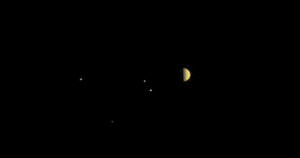|
NASA space probe to lift the veil on
Jupiter
 Send a link to a friend
Send a link to a friend
 [July 01, 2016]
By Irene Klotz [July 01, 2016]
By Irene Klotz
CAPE CANAVERAL, Fla. (Reuters) - NASA's
Juno spacecraft hurtled closer toward Jupiter on Friday headed for a
July 4 leap into polar orbit around the solar system's largest planet to
analyze how it formed and helped set the stage for life on Earth.
During a 20-month study, Juno is expected to circle the gas giant
in 37 egg-shaped orbits to measure microwaves radiating from inside
the planet's thick atmosphere, map its massive magnetic field and
conduct other experiments.
Scientists are particularly keen to learn how much water Jupiter
contains, a key to unlocking the origins of the largest celestial
body in the solar system after the sun.
Jupiter currently orbits the sun at a distance about five times
farther away than Earth, but it may have formed in a different
location and migrated, gravitationally elbowing aside other planets
along the way.
"Something happens that allows a star to be born and then afterwards
the planets ... That eventually leads to us," said the mission's
lead scientist, Scott Bolton, a space physicist with the Southwest
Research Institute in San Antonio, Texas.
 More than half of the material left over from the formation of the
sun 4.6 billion years ago ended up in Jupiter, which has a
circumference nearly 11 times bigger than Earth's and is itself
orbited by 67 known moons.
Jupiter is made almost entirely of hydrogen and helium, the two
simplest and most abundant elements in the universe, but the
planet's enormous mass generates such high pressure that the
materials behave in unexpected and unknown ways.
"We're working in a new environment," said Frances Bagenal, a
planetary scientist with the University of Colorado in Boulder. "We
don't know the physics of how things work at these high pressures.”
The Juno probe is named for the ancient Roman goddess, who was the
wife and sister of Jupiter, the mythological king of gods, and had
the power to see through clouds.
From vantage points as close as 3,000 miles (4,800 km) from the
planet's cloud tops, the spacecraft is to not only search for water
but assess whether Jupiter possesses a dense core beneath its
atmosphere.
[to top of second column] |

NASA's Juno spacecraft obtained this color view at a distance of 6.8
million miles (10.9 million kilometers) from Jupiter, on June 21,
2016. NASA/JPL-Caltech/SwRI/MSSS/Handout via Reuters

"We're about to embark on an incredible journey," Bolton said during
a news conference from the Jet Propulsion Laboratory in Pasadena,
California.
Juno, careening toward Jupiter at more than 160,000 miles per hour
(25,750 kph), over 200 times the speed of sound, has been programmed
to fire its braking rocket at 11:18 p.m. EDT on Monday in order to
slow its course.
The rocket must be precisely positioned and burn for 35 minutes to
reduce its speed enough to allow it to be captured by Jupiter's
gravity and swing into orbit.
"If that doesn't all go just right, we fly past Jupiter," Bolton
said.
Only one other spacecraft, NASA's Galileo space probe, has orbited
Jupiter, circling the planet for eight years before colliding with
the gas giant in 2003. The first spacecraft to fly past Jupiter was
NASA's Pioneer 10 in 1973.
Juno, which will arrive at Jupiter after a journey of five years and
nearly 2 billion miles (3.2 billion km), is expected to end its
mission as the Galileo probe did, crashing itself into the planet to
avoid possible contamination of Jupiter's ocean-bearing moon,
Europa, with any microbes carried by the spacecraft.
(Editing by Steve Gorman and Sandra Maler)
[© 2016 Thomson Reuters. All rights
reserved.]
Copyright 2016 Reuters. All rights reserved. This material may not be published,
broadcast, rewritten or redistributed.
 |